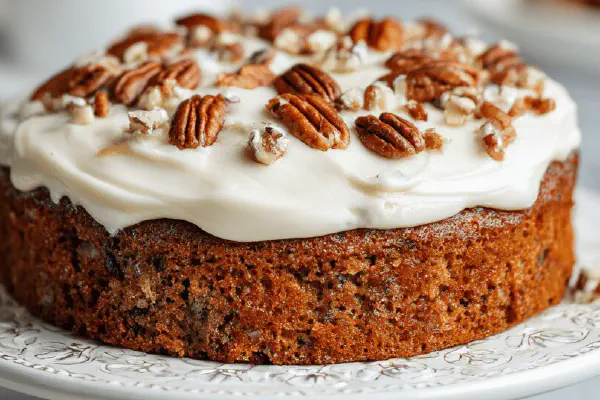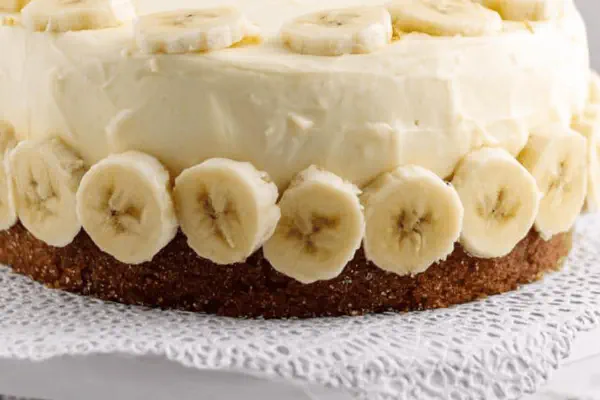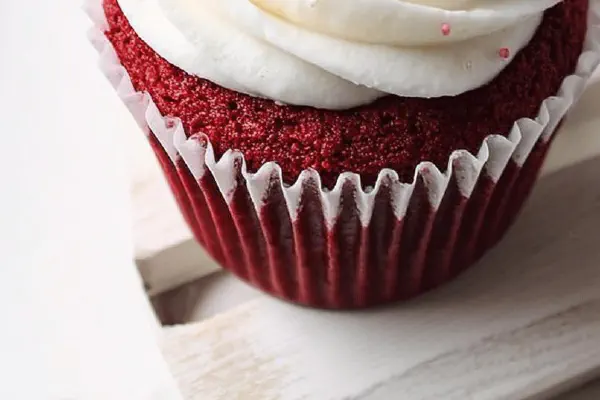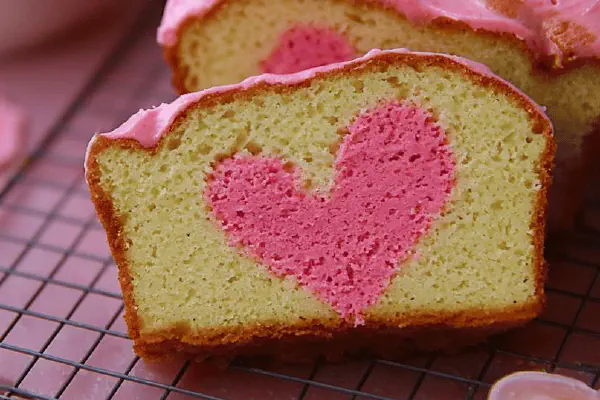Brown Butter Banana Cake

By Emma
Certified Culinary Professional
Ingredients
- 230 g unsalted butter
- 215 g all-purpose unbleached flour
- 6 ml baking powder
- 6 ml baking soda
- 1.5 ml fine salt
- 200 g packed light brown sugar
- 1 large egg
- 260 ml mashed overripe bananas thawed if frozen (about 3 medium)
- 140 ml sour cream
- 55 g toasted pecans chopped
Glaçage ===
- 250 g cream cheese softened
- 75 g icing sugar sifted
- remaining browned butter from above
- 8 whole toasted pecans for garnish
About the ingredients
Method
Cake
- Start with browning butter on medium heat in small saucepan. Swirl till foam stops, amber bits show. Smell it. Remove from heat immediately or risk bitter. Pour into heatproof bowl, set aside to cool but not harden.
- Position oven rack in center, preheat to 160 °C (320 °F). Grease 20 cm springform pan thoroughly; paper line bottom for easy release.
- In medium bowl, whisk together flour, baking powder, baking soda, salt. Important to sift or at least stir well so the rising agents distribute evenly.
- In large mixing bowl, blend 140 ml of browned butter and brown sugar with electric mixer till fluffy. Beat in egg thoroughly until light and homogenous.
- Add bananas next, mix gently at low speed - banana lumps bring texture, don’t overblend.
- Alternate adding dry mixture and sour cream, starting and ending with dry. Use folding or slow mix to avoid gluten development—keeps cake tender.
- Fold in pecans last, rough chopped; chopped nuts toasted intensify flavor and crunch.
- Transfer batter to pan, smooth top with spatula. Tap pan lightly on counter to remove big air pockets.
- Bake 52–57 minutes but check visually. Toothpick inserted near center should come out clean or with just moist crumbs. Edges will pull back lightly from sides, surface golden, slightly cracking.
- Cool on wire rack 20 minutes. Then unmold and cool fully, about 2 hours. Frosting goes on fully cooled cake or melts—big no.
Frosting
- With remaining browned butter (about 90 ml if possible), beat with cream cheese until fluffy. Gradually beat in sifted icing sugar until creamy and spreadable. Texture crucial here for neat finish.
Assembly
- Slice cake horizontally into two layers using serrated knife for even cut.
- Place bottom layer on serving plate. Spread half frosting evenly with offset spatula.
- Stack top layer gently. Coat entire cake with remaining frosting.
- Scatter whole toasted pecans over top.
- Chill under cake dome. Keeps 5 days refrigerated tightly sealed. Bring out 30 min before serving for best texture and flavor.
Substitutions and Tips
- Butter can swap with clarified butter but less nutty flavor. Sour cream replaced by Greek yogurt or crème fraîche for acidity.
- Bananas ripe or frozen, best if soft. Too firm bananas mean bland cake.
- If no pecans, walnuts or toasted almonds work but alter taste profile.
- Brown butter needs constant attention. Swirling pan helps even browning. Avoid black flakes.
- Alternate mixing dry and wet for crumb lightness; skipping makes dense rubbery cake.
- Over mixing egg-banana-butter batter develops gluten, so low speed is your friend.
- Test by smell as well: nutty brown butter aroma and banana sweetness fill kitchen when close to done.
- If cake darker edges but center raw, lower temp and extend baking.
- Remove cake quickly after baking or residual heat toughens crust.
- Cooling times essential—warm cake causes glossy, runny frosting mess.
- Try a splash of bourbon or rum with frosting for adult twist.
- Use silicone spatula folded gently, beating stiffens batter unnecessarily.
- If batter seems too thick, add small splash milk to loosen slightly.
- Use serrated bread knife for neat layer cutting; teeth bite through crumb better.
- Pecans toasted on dry pan stirring constantly for 4-5 min until fragrant but not burnt.
- Store cake tightly covered to prevent drying out; fridge fridge fridge but remember frost temp!
- Serve with espresso or black tea to balance sweetness and fat.
Cooking tips
Chef's notes
- 💡 Brown butter needs your full attention medium heat swirl constantly then smell nutty amber bits show no burning. Stop heating immediately or bitterness ruins cake base. Watch foam carefully don’t let it settle into black flakes. Use a heatproof bowl to cool but don’t let solidify before mixing.
- 💡 Alternate adding dry flour mix and sour cream starting and ending with dry dry mix folded or mixed slow to keep crumb tender. Skip this and gluten wakes up making dense rubbery cake. Mix bananas in gently with lumps intact; overbeating kills chunk texture which adds character.
- 💡 Toast pecans on dry pan 4 to 5 minutes stirring often till fragrant and just turning golden. Burnt nuts throw bitter notes so watch closely. Chop nuts roughly to keep crunch contrast inside cake batter. Can swap nuts for toasted walnuts or almonds but flavor changes noticeably.
- 💡 Use 20 cm springform lined bottom with paper. Grease sides thoroughly for easy release. Tap pan lightly on counter after filling to pop large air pockets or uneven crumb. Oven set lower than usual 160 Celsius to avoid cracking and dark edges but slow bake till toothpick comes out clean with moist crumbs, not sticky batter.
- 💡 Frost only once cake cools completely or frosting melts. Beat softened cream cheese well with leftover browned butter then sifted icing sugar gradually to keep creamy spreadable texture. Spread frosting with offset spatula thin layers for neat finished look. Chill cake under dome to seal freshness but bring out 30 minutes before serving to avoid dense cold mouthfeel.
Common questions
How do I know brown butter is ready?
Watch foam bubble change. Starts frothy then amber bits form swirling. Smell changes from creamy dairy to nutty toasted. Stop right then no delay cause bitterness quickly follows. Foam subsides but keep stirring to avoid burning.
Can I replace pecans?
Yes walnuts or almonds toasted dry work but expect texture and flavor shift. Pecans bring buttery taste. Nuts toasted but not blackened keep crunch without bitterness. No nuts? Add vanilla extract splash to frosting for some depth.
Why does cake get rubbery sometimes?
Over mixing especially when adding wet ingredients or bananas. Gluten develops too much. Alternate dry and wet mixing slow and fold. Overbeating eggs alone can toughen crumb too. Keep speed low to medium and mix just enough.
How best to store this cake?
Refrigerate covered tightly cake dome or container. Keeps moist for 5 days. Bring out 30 minutes before serving to soften crumb and frosting texture. Room temp up to few hours okay. Freeze not ideal; frosting texture suffers. Avoid drying by wrapping well.



